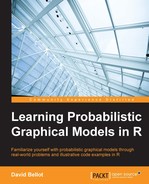In this chapter, we saw the standard linear model. This model is one of the most important models in statistics and provides a simple, additive way to represent relationships between observed variables and a target.
Estimating good parameters for a linear model can be hard sometimes and one should be very careful not to trust the results immediately. However, a Bayesian approach to the problem helps to include prior knowledge into the model and drive it toward a more stable and usable solution.
We saw ridge regression and Bayesian linear regression. We saw that, when the parameters have a Gaussian prior, then these two approaches are equivalent and very easy to compute.
Using a simple example, we saw that a standard regression can lead to completely over-fitted results and that the Bayesian approach solved the problem.
In the next chapter, we will look at more advanced models for dealing with clusters of data, called mixture models. These models make the assumption that the data is generated by a different group and the goal will be to automatically discover the group and reveal the hidden process behind it.
